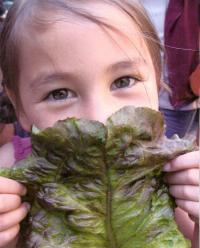Cultivating Healthy, Lifelong Learners
In the Atlantic's "Cultivating Failure," school garden programs are blamed for cheating students out of hours of important book learning and lowering test scores. Our response cites multiple studies that refute this argument, demonstrating that school gardens provide experiential learning that results in higher academic performance and healthier kids. We invite you to read our response and make your voice heard -- submit your own letter to the editor and tell your school garden success story!
Article author Caitlin Flanagan proposes that the best education for kids is one in which they are completely focused on “reading important books or learning higher math.” Students would remain disconnected from their source of food, the act of growing and tending it, and ignorant about the benefits of healthy eating.
School Gardens Cultivate Healthy Kids 
According to the State Boards of Education, children who eat well learn better, while poorly nourished students tend to have weaker academic performance and score lower on standardized achievement tests. Poor nutrition also interferes with cognitive function and is associated with lower academic achievement.1
School gardens have been proven to be a key part of teaching kids about healthy food. In nutrition education projects, elementary school children studied nutrition in the classroom while growing vegetables outdoors in their own gardens. Students’ nutrition knowledge increased as did their preference for vegetables.2 Another study by the California Department of Health Services demonstrated that students who had experienced gardening ate more fruits and vegetables as a result of the gardening program.3
Flanagan never makes this connection between garden programs, nutrition, and academic achievement. She abandons the idea of teaching school kids living in poverty about healthy eating because, she says, “The suicidal dietary choices of so many poor people are the result of a problem, not the problem itself. The solution lies in an education that will propel students into a higher economic class, where they will live better and therefore eat better.”
 But we cannot delay teaching healthy eating habits, since food preferences develop in early childhood.4 Allowing children to continue to make poor dietary choices can increase risks for diabetes, obesity, cancer, and heart disease.5
But we cannot delay teaching healthy eating habits, since food preferences develop in early childhood.4 Allowing children to continue to make poor dietary choices can increase risks for diabetes, obesity, cancer, and heart disease.5
School Gardens Cultivate Lifelong Learners
Flanagan also touts the value of book learning, and says she has spent “many hours poring over the endless research on the positive effects of garden curricula, and in all that time, I have yet to find a single study that suggests classroom gardens help students meet the state standards for English and math.”
It’s surprising that Flanagan could not find empirical research supporting the academic benefits of garden curricula, since there is plentiful evidence. Studies of the impact of school gardens in Louisiana and Indiana have shown that students score higher in science achievement tests than students who only engage in classroom curriculum.6
Moreover, according to a study at Evergreen University, schools that undertake systemic environmental education (EE), which includes school gardens, consistently have higher test scores on the state standardized tests over comparable “non-EE” schools.7 Another study by the State Education and Environment Roundtable in Washington D.C. observed benefits of environmental education such as better performance on standardized tests in reading, writing, mathematics, and social studies.8
 School gardens use the environment as a comprehensive framework for learning in all areas: general and disciplinary knowledge; thinking and problem-solving skills, and basic life skills, such as cooperating and interpersonal communications. In a study of 40 schools engaged in environmental education, first-hand experiences in applying math to authentic problems helped students understand these skills more thoroughly than traditional education. Better mastery of math skills was seen in 92% of the cases studied. 9 In addition to improving test scores, school gardens have been shown to
reduce classroom discipline problems and lead to increased enthusiasm
for learning.10
School gardens use the environment as a comprehensive framework for learning in all areas: general and disciplinary knowledge; thinking and problem-solving skills, and basic life skills, such as cooperating and interpersonal communications. In a study of 40 schools engaged in environmental education, first-hand experiences in applying math to authentic problems helped students understand these skills more thoroughly than traditional education. Better mastery of math skills was seen in 92% of the cases studied. 9 In addition to improving test scores, school gardens have been shown to
reduce classroom discipline problems and lead to increased enthusiasm
for learning.10
Flanagan compares the rising test scores of black and Latino students at a gardenless charter school to the less-than-average performance of Latino students at Berkeley’s public King Middle School, which has a school garden. She cites this difference as evidence that school gardens are an impediment to student learning. But whatever the differences in practices these two schools may have, the difference in performance cannot be blamed on school gardens.
School garden programs are part of the curriculum at environmental charter schools with academic achievement that is often better than average. At the Environmental Charter High School in Los Angeles, students perform better than the average in biology, life science, language arts, and history. At River Crossing, an environmental charter school in Portage, Wisconsin, students have fared as well or better than a traditional nearby school in all subjects — including eighth-grade reading, math, science, and social studies.
Environmental education, when done well, is understood by policymakers nationwide to be a key element of improving student health and academic achievement. Broad-based environmental education, including hands-on, outdoor education in gardens, is also the foundation for creating the green workforce of tomorrow, not simply lettuce pickers as Flanagan implies (with no disrespect for the hard and important work done by farm workers everywhere). The U.S. Department of Education is working to amend the Elementary and Secondary Education Act to include The No Child Left Inside Act, which would provide new funding for environmental education, particularly to develop rigorous standards, train teachers, and to develop state environmental literacy plans.
Flanagan may be reacting, somewhat rightly, to a sanctimonious, self-righteous attitude she has encountered by some who expound on the topic of healthy food. The quote by California’s superintendent of instruction, which suggests that immigrant parents are more comfortable volunteering in a garden program than elsewhere in the school, could be seen as patronizing. But regardless of how artlessly the message is conveyed, it doesn’t mean that all people – regardless of race or class – would not do well by getting their hands dirty and understanding the importance and value of healthy, fresh food and our place in the ecosystem.
1 http://www.wellnessandpreventionoffice.org/PE_DOCS/nutrition_physical.pdf , http://www.indianaactionforhealthykids.org/Resources/The%20Role%20of%20Sound%20Nutrition%20and%20PA%20in%20Academic%20Achievement.pdf
2 J. Morris, A. Neustadter, and S. Zidenberg-Cherr, “First-grade Gardeners More Likely to Taste Vegetables,” California Agriculture, (January-February 2001),43 J. Morris and S. Zidenberg-Cherr, “Garden-enhanced Nutrition Curriculum Improves Fourth-grade School Children’s Knowledge of Nutrition and Preferences for Some Vegetables,” Journal of the American Dietetic Association, Vol. 102 (2002), 24.
3 S. Foerster, J. Gregson, and D.L. Beall, “The California Children’s 5-A-Day Power Play! Campaign: Evaluation of a large-scale social marketing initiative,” Family and Community Health, Vol. 21 (1998), 46.
4Kirby, S.D., Baranowski, T., Reynolds, K., Taylor, G. Children's Fruit and Vegetable Intake: Regional, Adult-Child, Socioeconomic, and Urban-Rural Influences. Journal of Nutrition Education (Oct, 1995).
5 http://www.sdchip.org/work_teams/wt_na/wt_na_pdfs/G-nutrition%20edited.pdf , http://www.ericdigests.org/1994/nutrition.htm
6 Smith, Leanna L. and Carl Motsenbocke. 2005. Impact of hands-on science through school gardening in Louisiana Public Elementary Schools. HortTechnology, 15 (3) 439-443, Klemmer, C.D., T.M. Waliczek, and J.M. Zajicek. 2005. Growing Minds: The effect of a school gardening program on the science achievement of elementary students. HortTechnology, 15 (3) 448-452. 7 http://www.seer.org/pages/research/Bartosh2003.pdf
8 http://eric.ed.gov/ERICDocs/data/ericdocs2sql/content_storage_01/0000019b/80/29/c1/70.pdf
9 Closing the Achievement Gap (1998 Gerald A. Lieberman and Linda L. Hoody)











